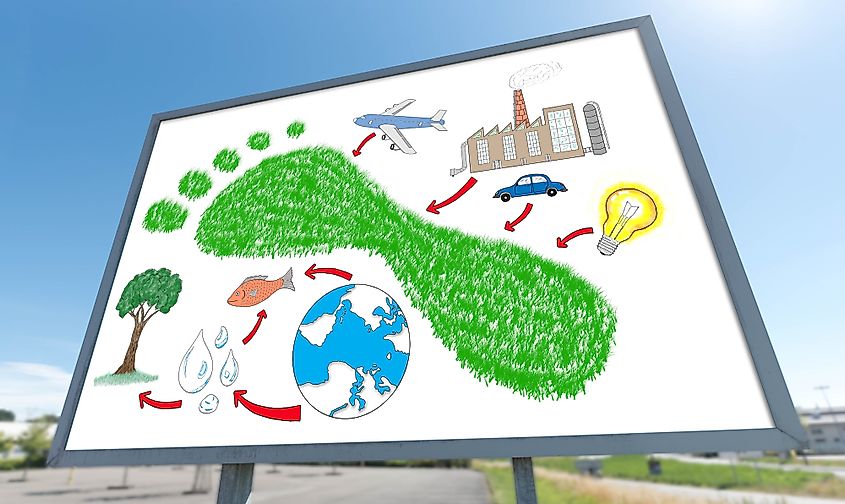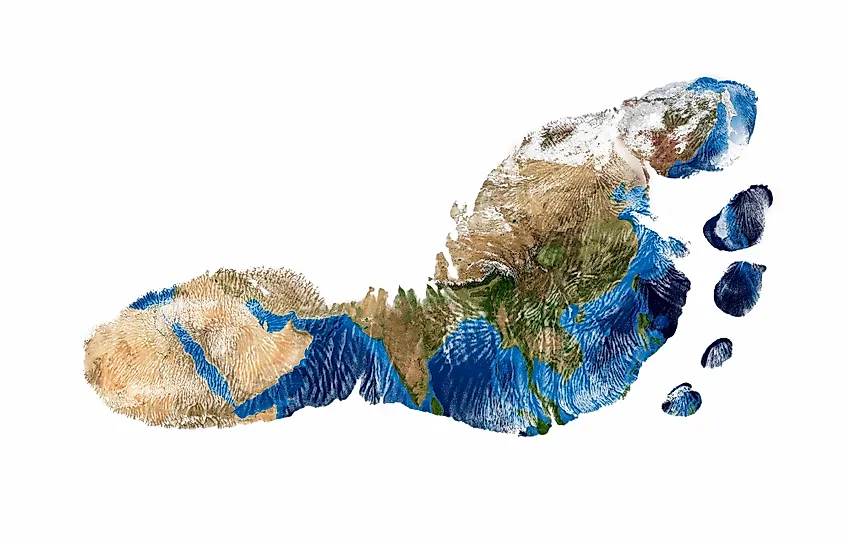What Is An Ecological Footprint?

- An ecological footprint measures our impact on the environment, represented in the amount of land and natural resources that are used to meet our demands.
- It would take a full Earth and a half to produce the amount of resources needed to meet current human demand—two Earths by the year 2050.
- Due in part to free access to electricity and water, Qatar is generally considered the country running the biggest ecological deficit.
Everything from driving expensive sports cars to buying a single candy bar affects the planet. Whether it is to power our homes, produce food, or maintain personal hygiene, we as humans go through and use up an immense amount of natural resources, some of which are necessary for our survival, while others are not. These resources are typically supplied by our planet; however, it has become increasingly apparent in recent years that they are not unlimited. This creates a very real problem, even if much of it remains invisible to the average consumer. To address this issue, we must examine our ecological footprint.
An ecological footprint measures our impact on the environment, represented in the amount of land and natural resources that are used to meet our demands. The ecological assets it takes into consideration include livestock, food, water, timber, and space for urban growth, among other things. Knowing our ecological footprint can help us understand our individual and collective impact on nature, and inspire us to lead more sustainable lives.
How Is Ecological Footprint Determined?

An ecological footprint can be calculated on many scales from the individual to the entire planet. It is usually measured in standard units called global hectares. Determining our impact on the planet can be quite complex and require specific calculations depending on the subject. Nonetheless, as hinted above, it essentially follows a basic supply and demand model.
The supply aspect comes in the form of biocapacity, also known as biological capacity. It represents the productivity of the designated area’s ecological assets. In other words, it is an estimate of the capacity of an area to generate a supply of resources. Several factors come into play when calculating biocapacity, including how productive each global hectare is or how many people share this biocapacity. Regardless, these areas are generally broken down into six categories: cropland, grazing land, forest area, fishing grounds, built-up land, and carbon demand on land. The ecological footprint itself represents the demand aspect, or how much we require and use these natural resources.
When an ecological footprint is compared to biocapacity, we get a read on how sustainable that region is in relation to the subject’s needs. If the ecological footprint exceeds the region’s biocapacity, it is running an ecological deficit, meaning the need for resources is too great. If the region’s ecological footprint is lower, than it is an ecological reserve, meaning nature can keep up with human demand.
How To Reduce Ecological Footprint?

To live sustainably within the means of our planet’s resources, our ecological footprint has to equal or be less than the biocapacity available per person. This simple fact continues to be a problem as we are exceeding our biocapacity at alarming rates. According to the World Wildlife Federation, it would take a full Earth and a half to produce the amount of resources needed to meet human demand—two Earths by the year 2050. Simply put, humanity’s ecological footprint is just too much for our planet to bear. However, there are many solutions and initiatives that we as individuals can support to help reduce these figures.
- Reduce waste as landfills are quickly becoming overburdened. Buy fewer unnecessary items, particularly if they come with an egregious amount of packaging. Recycle more and reuse what you can. Also, be on the lookout for biodegradable and non-toxic products.
- Try to avoid single-use plastics as they could take up to a thousand years to properly decompose. Instead of drinking from plastic water bottles or accepting store-provided grocery bags, buy reusable ones.
- Reduce water use. Take shorter showers and run dishwashers and washing machines only when full. To do otherwise is harmful to the hundreds of millions of people around the world who do not have access to clean water.
- Drive less as exhaust is one of the biggest pollutants contributing to global warming. When possible, bike or take public transit. It is better for the environment and costs less money.
- Switch to renewable energy. This can be a big act such as installing solar panels, or something small like using energy-saving lightbulbs.
Which Country Has The Highest Ecological Footprint?

Most countries have specific offices that collect data regarding economic activities and energy consumption to calculate their impact on the environment.
There is some disagreement between sources as to which country has the highest ecological footprint, but Qatar is generally considered one of the worse. It is a small Middle Eastern country with a current population of 2.8 million people. If every human lived as the average person in Qatar, Earth would need roughly five times the natural resources it has to meet demand. Blaming the local oil industry would seem logical, but in reality, Qatar’s ecological deficit is a result of immense high-energy usage. Citizens are provided with free electricity and water, which only increases the demand on energy. In fact, air conditioners and the desalination of seawater is responsible for the seven percent spike in energy usage every year. Other Middle Eastern countries with high ecological footprints include the United Arab Emirates and Bahrain.
Other studies show that China has the largest ecological footprint. As income rises, so is individual consumption, but with a population of 1.4 billion people, China’s resources are also quickly dwindling.
Regardless of which country has the biggest impact on the environment, one thing is certain: too many countries are running ecological deficits. Things need to change if we are to protect our planet, and by extension, ourselves.











